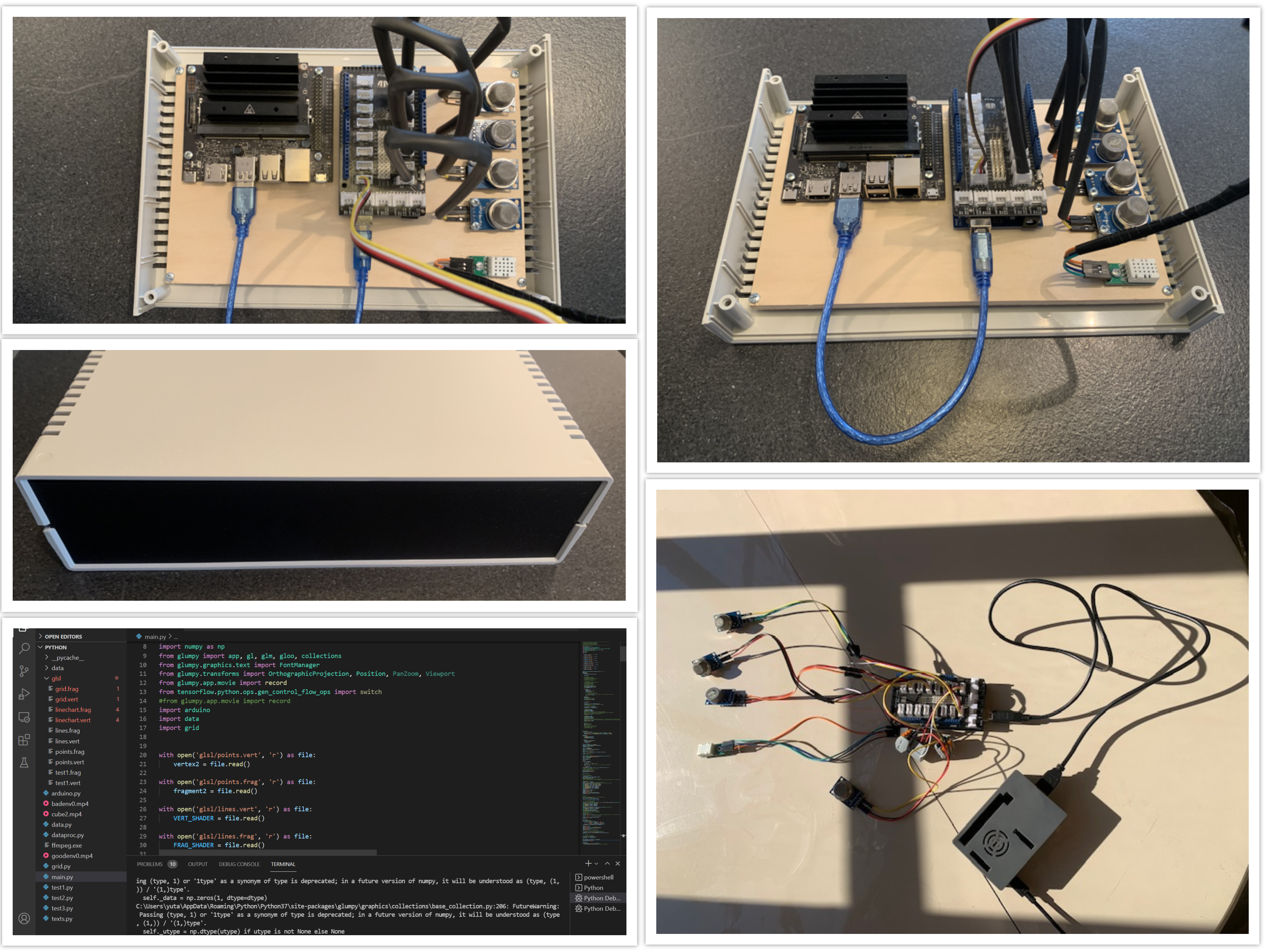CRYPTOSPIRITS
“Because data lives in an intangible space, the only way to coax it into the physical world is through artistic expression, just as our ancestors found new ways to create meaning with pigment and stone.” Ref. The Age of Date. Embracing Algorithms in Art and Design.
CryptoSpirits is an ongoing exploration at the intersection of contemporary technology, ancient animism and the impact of pollution in the face of climate change.
The starting point is to develop dynamic NFTs whereby the raw data is rooted in the natural environment, preferably in polluted areas. The second goal is to develop a portable low cost solution that democratises state-of-the-art technologies to drive social innovation, support the regeneration of the natural environment supercharged by embedded artificial intelligence (Jetson Nano) and (glocal) communities.
Utilizing custom hardware, sensors, and code, the project captures and transforms environmental pollution into real-time data-driven CryptoSpirit NFTs, serving as virtual indicators of the health of the natural environment.
By combining art, science, and technology, CryptoSpirits raises awareness about environmental issues and leverages the power of NFTs and blockchain technology to record environmental pollution and historical climate data. The results are dynamic NFTs that combine abstract generative data visualisations with actual empirical data.
The visual aesthetic will depend on the series. Currently there are series inspired by e.g. geometric patterns found in e.g. oriental carpets -also depicted in Renaissance paintings-, weaving patterns and tessellations, western glitch aesthetics and color field art:
- In the “Data Weaving” installment of the CryptoSpirits series, the artist delves into the intricate interplay between weaving and computing. The advent of the Jacquard weaving process in 1801 marked a seminal moment in the evolution of computing. This innovative process involved providing instructions to a loom using punched holes in paper cards, a rudimentary form of binary code. The legacy of the Jacquard loom can be traced in the design of Charles Babbage’s Analytical Engine (1834), a precursor to modern computing and algorithms. The engine borrowed several key elements from the Jacquard loom, including the punch card, which remained a prevalent means of programming and inputting data into computers until the 1980s. The end result of this project will be a phygital artwork, comprising of an NFT and a corresponding Jacquard/tapestry, that showcases the symbiotic relationship between weaving and computing in both Eastern and Western cultures.
- The Magnum Opus is a digital embodiment of the CryptoSpirit deity, crafted from numerous dynamic NFTs made from recordings of polluted areas across the globe. This sublime creation will also have a tangible counterpart in the form of a stunning tapestry.
- https://versum.xyz/token/versum/32100
- https://versum.xyz/token/versum/32101
- https://versum.xyz/token/versum/32102
PHILOSOPHICAL FRAMEWORK
- The cyber sublime is a philosophical conception of emotions that captivate the collective conscience with the emergence of these new technologies and the promises and predictions that emerge from them. These emotions are the awe, the astonishment, the rationality-subsuming glory, and the generally intense spiritual experience. Ref. “The Digital Sublime: Myth, Power, and Cyberspace” by Professor Vincent Mosco.
- Techno-animism or technoanimism is a culture of technological practice where technology is imbued with human and spiritual characteristics. It assumes that technology, humanity and religion can be integrated into one entity.
HARDWARE
- Gas sensors
- MQ2 Sensitive for Methane- Butane-LPG- smoke.
- MQ4 Sensitive for Methane- CNG Gas.
- MQ5 Sensitive for Natural gas- LPG.
- MQ9 Sensitive for Carbon Monoxide- flammable gasses.
- Water pollution sensor (recently added sensor).
- High precision digital temperature and humidity Sensor SHTC3
- Arduino Mega microcontroller
- Jetson Nano/Raspberry Pi
SOFTWARE
Glumpy – a library for scientific dataviz which connects OpenGL and Numpy (package for scientific computing with Python). It’s a multi-platform solution that will run on any computer including Raspberry, Jetson or Windows.
Data visualization algorithm consists of next items:
- Data from the air and water sensors are read into a multidimensional array. Further, using the t- SNE and KMeans clustering algorithms, the data dimension is reduced to 3-dimensional. There is also a division into 4 clusters, where each cluster is indicated by a separate color.
- There are lines which underlying the difference between reference signal and the current signal from the air sensors. The bigger this difference the more visible these lines become that makes the figure more sinister.
- The color of these lines depends on values from the water quality sensor. The worse the quality of the water, the more the color of the lines is closer to red, the better the water, the closer the color of the lines to blue.
Python sources for Jetson Nano:
All the sources are located on the path
/home/user/cspirits/
The most important files are:
configs.py – is the file where you can configure the next paremeters
winwidth, winheight = 1360, 768 #1920, 1080 videoDir = ‘/home/user/cspirits/python/videos/’ artDir = ‘/home/user/cspirits/artvideo/’
gifDir = ‘/home/user/cspirits/artgif/’ datavizLengthSecs = 10.0
videoLengthSecs = 5.0 filesCountLimitatoin = 4
controller.py – is the start point of the program. It is where starts render and player processes.
main.py – the main file where starts sensor’s data collection, math processing and rendering
/demo/index.js – JS + glsl script for generating art gif
Sequence:
1) the web player starts with the last two (dataviz and art) video files in the loop
2) data accumulation and dataviz rendering are started at the same time
3) when the new dataviz file is ready, the gif art video renderer starts using web browser + js + glsl 4) when the gif file is ready, it will be converted to mp4
After the new dataviz and art videos are ready, the web player starts with new video files. and the whole cycle repeats itself.
GENERAL DESCRIPTION
In the world of digital art, artists are now creating NFTs. Frederik De Wilde conceptualised environmental NFTs that represent the state of the natural environment and local pollution. These NFTs are a combination of abstract and empirical data visualizations made using custom code, sensors, and hardware, and they offer a unique perspective on the ways in which our environment is changing and being impacted by human activity.
The project explores how digital art connects with animism; the belief that everything in nature has a spirit or consciousness, and the reverence for natural forces and their influence on human life. The environmental NFTs could be seen as a modern form of animistic belief, where the natural environment and its health are represented by deities in the form of digital art. The NFTs serve as a reminder of the interconnection between humans and the natural world, and the need to respect and protect it, also because we are intrinsically part of the ecosystem.
The visualizations created using this technology are not only aesthetically striking, but they also provide a wealth of information about the environment and the ways in which it is being impacted. The use of custom code, sensors, and hardware allows the artist to capture a wide range of environmental data, including air and water quality, temperature, and noise levels, and to represent this information in a visual format that is easy and intuitive to understand and interpret. The results are both aesthetically pleasing and informative, and offer new and thought-provoking perspectives on the world around us.
The art historical relationship between the geometric patterns, that are a result of the data visualization, is perceived from an orient and occident perspective, offering a unique perspective on the ways in which different cultures and civilizations have approached the representation of information. The abstract nature of the visualizations allows for a wide range of interpretations.
The project offers tools for other artists to express their concerns and to raise awareness about the need for greater environmental protection.
Next steps:
- Performance optimization.
- Port to a desktop computer with powerful gpu.
- Enhancing visualization quality.
- Finalization of the construct.
- Automating the creation of NFT tokens.
* With the support of Innovatieve Partnerschappen van de Vlaamse Overheid.


